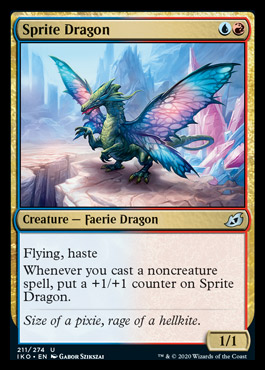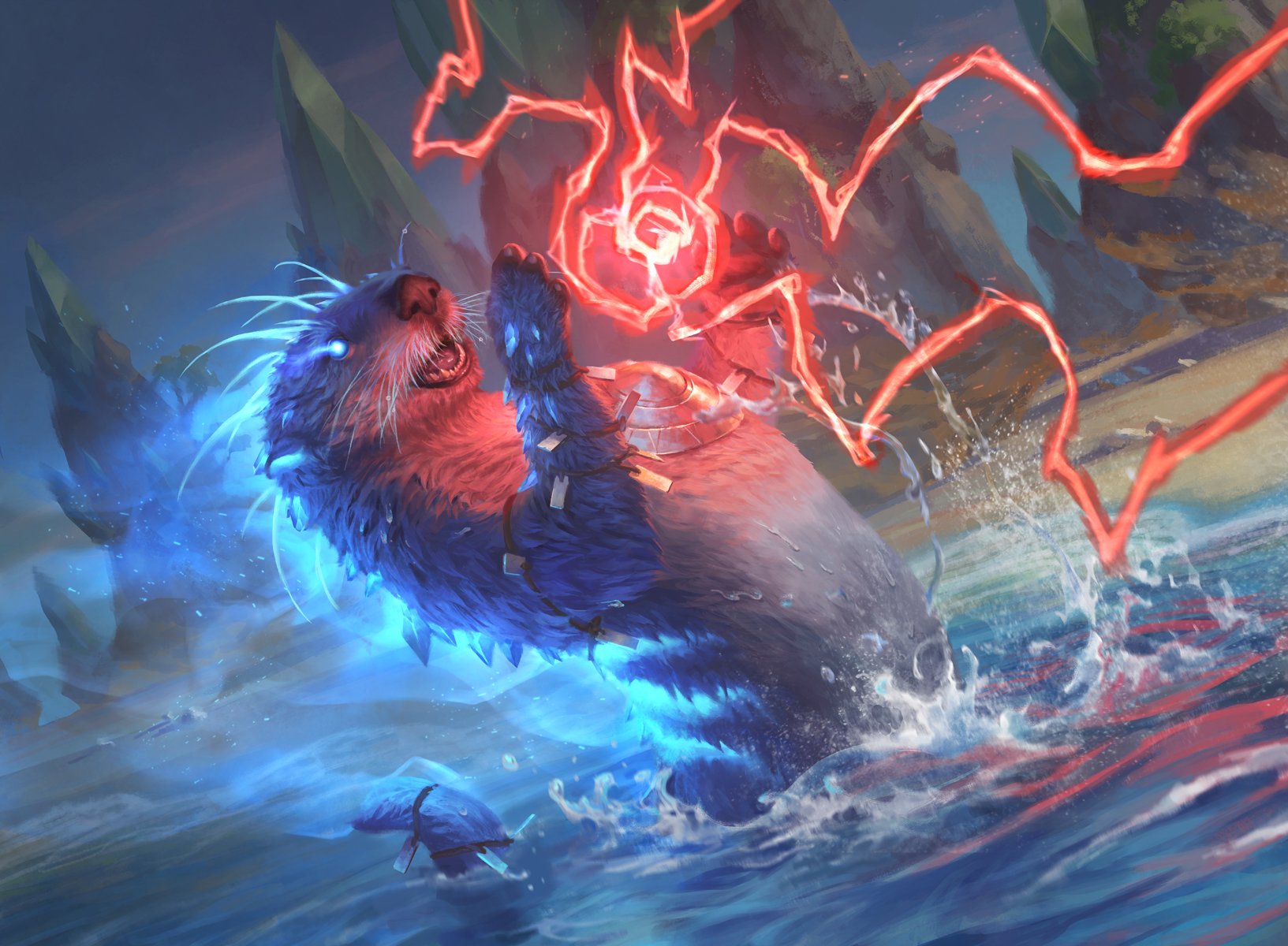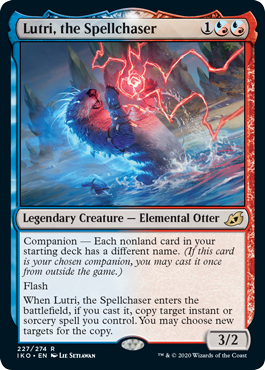When I was a young lad, articles during preview season warned of “power creep.” As the most otterly ridiculous cards from the upcoming set were previewed, immediate reactions gave way to a larger concern: Is this the new normal? As the best cards became stronger and stronger, sets that didn’t clear this new bar would seem underwhelming while those that pushed these boundaries too far risked breaking formats beyond repair.
Since 2019, those concerns seem more real than ever. War of the Spark and Modern Horizons gave us a glimpse of what was possible and Throne of Eldraine and Theros Beyond Death confirmed this as the new standard.
Ikoria: Lair of Behemoths is taking Magic design to unclaimed territory.
When looking for homes for new cards, we start by asking what deckbuilding incentives and restrictions they impose. Some of these are explicit – Setessan Champion wants you to play enchantments! – and some are harder to tease out – Fires of Invention is obviously powerful but it’s not immediately clear how to unlock that power. The mana system also defines these choices – Goblin Chainwhirler is a straightforward card but competes with colorless utility lands or strong commitments to other colors.
In the big picture, some broad truths have survived decades of experiments and changing design philosophies. You want to play the minimum number of cards required in a format; you want to play the maximum number of copies of your most powerful or synergistic cards; you want to have good ways to use your mana at most spots on the curve. Lutri, the Spellchaser and the rest of this cycle from Ikoria: Lair of Behemoths force us to challenge even these most fundamental assumptions.
Without this game-breaking new mechanic, Lutri is still a fine card that deserves consideration. There’s a lot going on even in its more mundane text. The hybrid mana cost opens doors that are closed to a traditionally multicolor Izzet card – other color pairs that include red rarely have enough cheap or high-impact spells to want this effect, but Azorius, Simic, and Dimir all have interest in a flash threat that can double up their removal or interaction.
Otters are sadly not a prominent creature type in Magic (yet!) but Elementals have been a fixture of Standard thanks to Risen Reef and occasionally Omnath, Locus of the Roil. These both reward you for playing a lot of creatures, which makes it hard to achieve the spell density needed to justify Lutri. Chandra, Acolyte of Flame is an excellent source of Elementals and shares the desire for cheap spells that also help to justify playing so many three-drops. In Pioneer, Young Pyromancer is the perfect addition to this package, while Stoke the Flames gives you a burn spell that keys off these tokens and is either free or cheap enough to be copied easily with Lutri. However, these shells are unlikely to be cohesive enough to be more than fringe players.
More importantly, Lutri is a welcome addition to the suite of flash threats that have performed well in Standard for months. The Izzet Flash decks that seemed poised to take over Mythic Championship VII in the days leading up to the tournament may make a triumphant return with Ikoria:
Creatures (14)
Lands (25)
Spells (21)

These spell-heavy aggro-control decks have always faced an awkward tension between playing enough spells to enable their threats and enough threats that they can still deploy pressure through a removal spell. The Adventure mechanic bridges this gap perfectly and Brazen Borrower and Bonecrusher Giant are the best of their kind. You’ll often be happy to deploy Lutri as the world’s cutest Whisper Agent to apply pressure, but getting to copy a spell in the mid-game will leave you far ahead.

Sprite Dragon is the card that Stormchaser Mage and Quirion Dryad always wanted to be. The prowess mechanic is at odds with reactive cards, as you want to use mana and cards on your own turn for a temporary damage boost, but counters are excellent at protecting a Sprite Dragon that’s become large enough to put the game away.
In Modern, this style of gameplay has been popular for years:
Creatures (16)
- 1 Vendilion Clique
- 4 Snapcaster Mage
- 3 Spell Queller
- 4 Brineborn Cutthroat
- 2 Brazen Borrower
- 2 Lutri, the Spellchaser
Planeswalkers (2)
Lands (21)
Spells (21)

Snapcaster Mage is a central card in these strategies and Lutri looks for similar tools – cheap instants that are good the first time and even better the next. The bar is higher and the space tighter in Modern but Flash decks benefit strongly from having a range of different cards at each spot on the curve. When an opponent has to play into your cards at sorcery speed, each additional possibility represented by open mana makes each other card in your range that much tougher to play around properly. Lutri may not be as powerful in the abstract as historical all-stars like Vendilion Clique but it serves a useful role as part of a squad.
Pioneer is an ideal home for Lutri, featuring more cheap spells than Standard but a lower barrier to entry than Modern. This variant of the Dimir Control deck proposed by Shaheen Soorani welcomes Lutri with open arms:
Creatures (6)
Planeswalkers (5)
Lands (25)
Spells (24)

Crucially, Pioneer is also the only format where we get to enjoy Treasure Cruise and Dig Through Time. These broken delve spells are already a strong incentive to play the same cheap spells that are best with Lutri – it’s hard to find better one-mana cards than Thoughtseize or Fatal Push – and quickly become cheap enough to be the best possible targets for it. Once again, a flash threat by itself is a surprisingly valuable asset in a format where blue mirrors revolve around planeswalkers like Narset, Parter of Veils; Teferi, Time Raveler; and Jace, Wielder of Mysteries.
Back in Standard we can revisit some promising shells from past preview seasons. As players geared up for War of the Spark, Ral, Storm’s Conduit stood out as a combo enabler. While Lutri is carefully worded to avoid the Finale of Devastation loops with Ral and Naru Meha, Master Wizard – and the inevitable Splinter Twin comparisons that came with them – it slots neatly into another combo with cards that already see heavy Standard play:
Creatures (6)
Planeswalkers (4)
Lands (27)
Spells (23)

Responding to a spell (ideally Opt) with Expansion and then a second Expansion targeting the first results in a loop that normally accomplishes nothing but adds up to infinite damage with Ral, Storm’s Conduit on the battlefield. While this may seem like a lot of moving parts, just doubling a single Explosion with Ral usually creates an insurmountable advantage and copying Ral’s Outburst or Storm’s Wrath in a pinch can stabilize the game. This list is less reliant on its namesake card than typical Temur Reclamation and these changes offer better counterplay against Teferi, Time Raveler – a card sure to be around in Standard no matter what heavyweights arrive from Ikoria: Lair of Behemoths. Lutri fits in here as a secondary means of Forking important spells as well as another threat to complement a sideboard pivot with Nightpack Ambusher or other creatures. This deck generates a lot of mana – especially during the end of your turn with Wilderness Reclamation – allowing Lutri to copy more expensive spells up to and including a large Explosion.
While copying big spells with Lutri is the dream, this often takes far too much mana to be realistic. Luckily, one of Standard’s best cards gives a substantial discount on expensive spells:
Creatures (13)
- 3 Bonecrusher Giant
- 4 Fae of Wishes
- 1 Brazen Borrower
- 3 Uro, Titan of Nature's Wrath
- 2 Lutri, the Spellchaser
Lands (29)
Spells (18)

Temur Fires has received surprisingly little interest and some new tools from Ikoria: Lair of Behemoths may give it the attention it deserves. Lutri does its usual work here but Fires of Invention makes it trivial to copy a Drawn from Dreams, Storm’s Wrath, a Granted target, or Granted itself.
Each of these shells may be exciting in one way or another, but that’s not why we’re here! The appeal of Lutri is making sense of the unique challenge the companion clause presents in deckbuilding. Is on-demand access to Lutri really worth warping your deck in such an extreme way?
It’s hard to have any frame of reference for that question. Only a select few old-school Magic Online grinders have much experience with competitive Highlander or Singleton formats – and even there, deckbuilding is informed by the knowledge that everyone else is operating under the same constraint. Commander decks are superficially similar but heavily tailored to individual playgroups with their own goals, usually for casual multiplayer play. Committing fully to Lutri sounds fun in the way that Battle of Wits does, but does it ever make sense if your main goal is to win?
Before we dive into the unknown, some important points on how companion works as it pertains to Lutri:
- For Constructed, “starting deck” refers to the configuration of 60 or more cards you present in each game of a match.
- It’s possible for a deck to meet the companion requirement in one game but not others. For example, your maindeck might contain one Aether Gust with more in the sideboard – if any additional copies are brought in, Lutri cannot be your companion.
- Companion operates from the sideboard – to use Lutri as a companion, it must occupy one of your fifteen sideboard slots. Only one companion can be used per game and your choice of companion must be declared before the game starts.
What does this restriction mean in practice?
- Any deck that relies heavily on a particular card or interaction is off the table. The old chestnut that, if a deck is named after a card, you need to make sure you can reliably find that card certainly applies here.
- On the other end of the spectrum, a deck that cares about redundancy of a certain effect is a no-go unless there are many playable versions of it. A deck like Burn has no interest in Lutri regardless but it’s a good example of a strategy that disqualifies Lutri on those grounds – downgrading top-shelf burn spells to barely playable ones is just too big a cost.
- If a strategy typically cares a lot about sideboarding, Lutri has a much higher bar to clear as it’s likely to only be relevant in one game.
This leaves strategies that are interested in broad classes of cards but aren’t overly reliant on any single card and those that care enough about copying certain spells that it’s worth mangling the rest of the deck. Frank Karsten showed that a singleton Azorius Control deck could stand its ground in Modern’s ancestor a decade ago and that’s a good starting point in these exciting times:
Creatures (6)
- 1 Venser, Shaper Savant
- 1 Vendilion Clique
- 1 Wall of Omens
- 1 Snapcaster Mage
- 1 Jace, Vryn's Prodigy
- 1 Brazen Borrower
Planeswalkers (4)
Lands (26)
Spells (24)
- 1 Wrath of God
- 1 Mana Leak
- 1 Serum Visions
- 1 Opt
- 1 Fact or Fiction
- 1 Remand
- 1 Condemn
- 1 Ancestral Vision
- 1 Cryptic Command
- 1 Path to Exile
- 1 Day of Judgment
- 1 Spreading Seas
- 1 Deprive
- 1 Oust
- 1 Thought Scour
- 1 Azorius Charm
- 1 Supreme Verdict
- 1 Anticipate
- 1 Blessed Alliance
- 1 Search for Azcanta
- 1 Dovin's Veto
- 1 Force of Negation
- 1 Archmage's Charm
- 1 On Thin Ice
Sideboard

If you’d rather mangle your deck to chase that high, you can do that too. As Sam Black highlighted in discussing a hypothetical Modern Highlander format, it’s possible to build a Taking Turns or Turbo Fog deck with this constraint. When taking another turn is the main goal on every turn, access to a virtual extra turn and a clock via Lutri is incredibly valuable. This makes this shell the most likely candidate to give Lutri its forever home:
Creatures (4)
Planeswalkers (1)
Lands (26)
Spells (29)
- 1 Time Warp
- 1 Regrowth
- 1 Sleight of Hand
- 1 Exhaustion
- 1 Serum Visions
- 1 Gifts Ungiven
- 1 Opt
- 1 Fact or Fiction
- 1 Life from the Loam
- 1 Remand
- 1 Gigadrowse
- 1 Utopia Sprawl
- 1 Ancestral Vision
- 1 Search for Tomorrow
- 1 Cryptic Command
- 1 Savor the Moment
- 1 Explore
- 1 Deprive
- 1 Noxious Revival
- 1 Thought Scour
- 1 Temporal Mastery
- 1 Temporal Trespass
- 1 Search for Azcanta
- 1 Nexus of Fate
- 1 Growth Spiral
- 1 Wilderness Reclamation
- 1 Force of Negation
- 1 Archmage's Charm
- 1 Veil of Summer
Sideboard

Of course, another home for Lutri is a format where the spells are so powerful that many of them are restricted to begin with. Mystic Sanctuary looping Ancestral Recall and Time Walk quickly cemented itself as a key tactic in Vintage and it’s hard to imagine better Lutri targets.
Vintage has never been more accessible on Magic Online – if you haven’t given it a try yet, you really otter…




